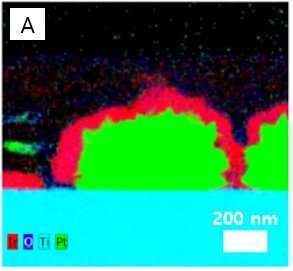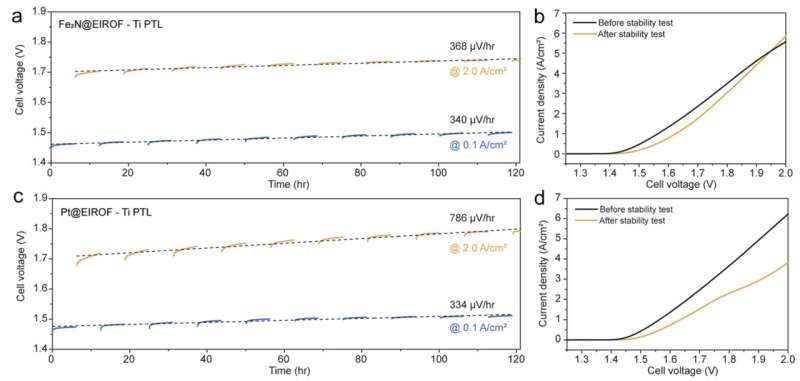This article has been reviewed according to Science X's editorial process and policies. Editors have highlighted the following attributes while ensuring the content's credibility:
fact-checked
proofread
Developing technologies to reduce the cost of green hydrogen production

Green hydrogen, which produces hydrogen without the use of fossil fuels or the emission of carbon dioxide, has become increasingly important in recent years as part of efforts to realize a decarbonized economy. However, due to the high production cost of water electrolysis devices that produce green hydrogen, the economic feasibility of green hydrogen has not been very high. However, the development of a technology that drastically reduces the amount of rare metals such as iridium and platinum used in polymer electrolyte membrane water electrolysis devices is opening the way to lower production costs.
A research team led by Dr. Hyun S. Park and Sung Jong Yoo of the Hydrogen and Fuel Cell Research Center at the Korea Institute of Science and Technology (KIST) announced that they have developed a technology that can significantly reduce the amount of platinum and iridium, precious metals used in the electrode protection layer of polymer electrolyte membrane water electrolysis devices, and secure performance and durability on par with existing devices.
In particular, unlike previous studies that focused on reducing the amount of iridium catalyst while maintaining the structure that uses a large amount of platinum and gold as the electrode protection layer, the researchers replaced the precious metal in the electrode protection layer with inexpensive iron nitride having large surface area and uniformly coated a small amount of iridium catalyst on top of it, greatly increasing the economic efficiency of the electrolysis device.
The polymer electrolyte membrane water electrolysis device is a device that produces high-purity hydrogen and oxygen by decomposing water using electricity supplied by renewable energy such as solar power, and it plays a role in supplying hydrogen to various industries such as steel making and chemicals. In addition, it is advantageous for energy conversion to store renewable energy as hydrogen energy, so increasing the economic efficiency of this device is very important for the realization of the green hydrogen economy.
-

(A) Catalyst shapes made with conventional technology (red-iridium catalyst/green-platinum). Credit: Korea Institute of Science and Technology -

(B) Catalyst shape made with the new technology (red-iridium catalyst/green-iron nitride). Credit: Korea Institute of Science and Technology
In a typical electrolysis device, there are two electrodes that produce hydrogen and oxygen, and for the oxygen generating electrode, which operates in a highly corrosive environment, gold or platinum is coated on the surface of the electrode at 1 mg/cm2 as a protective layer to ensure durability and production efficiency, and 1-2 mg/cm2 of iridium catalyst is coated on top. The precious metals used in these electrolysis devices have very low reserves and production, which is a major factor hindering the widespread adoption of green hydrogen production devices.
To improve the economics of water electrolysis, the team replaced the rare metals gold and platinum used as a protective layer for the oxygen electrode in polymer electrolyte membrane hydrogen production devices with inexpensive iron nitride (Fe2N).
To do so, the team developed a composite process that first uniformly coats the electrode with iron oxide, which has low electrical conductivity, and then converts the iron oxide to iron nitride to increase its conductivity. The team also developed a process that uniformly coats an iridium catalyst about 25 nanometers (nm) thick on top of the iron nitride protective layer, reducing the amount of iridium catalyst to less than 0.1 mg/cm2, resulting in an electrode with high hydrogen production efficiency and durability.
The developed electrode replaces the gold or platinum used as a protective layer for the oxygen generating electrode with non-precious metal nitrides while maintaining similar performance to existing commercial electrolysis units, and reduces the amount of iridium catalyst to 10% of the existing level. In addition, the electrolysis unit with the new components was operated for more than 100 hours to verify its initial stability.

"Reducing the amount of iridium catalyst and developing alternative materials for the platinum protective layer are essential for the economical and widespread use of polymer electrolyte membrane green hydrogen production devices, and the use of inexpensive iron nitride instead of platinum is of great significance," said Dr. Hyun S. Park of KIST. "After further observing the performance and durability of the electrode, we will apply it to commercial devices in the near future."
The research results were published online in the journal Applied Catalysis B: Environmental.
More information: Hui-Yun Jeong et al, High–performance water electrolyzer with minimum platinum group metal usage: Iron nitride–iridium oxide core–shell nanostructures for stable and efficient oxygen evolution reaction, Applied Catalysis B: Environmental (2023). DOI: 10.1016/j.apcatb.2023.122596


















